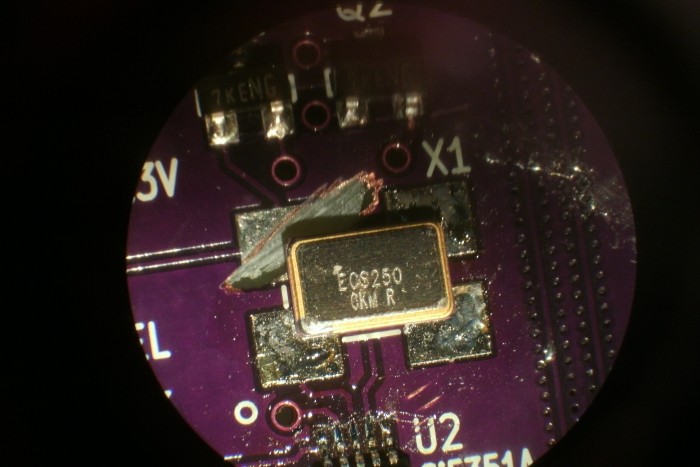[Yesterday: 3.4 miles, today: 0]
Parts arrived in the mail yesterday and I fired up the old soldering iron to put them on the Si5351A Breakout Board designed by Jason, NT7S which I received a few days ago.
I discovered that I pulled the trigger a bit too soon on my parts order, having forgotten to get one value of capacitor and one value of resistor. But I was able to find some useable parts in my junkbox on an old CD-ROM controller board.
This thing I’m soldering on uses surface mount parts. A few years ago I was able to pick up a low power stereo microscope and that’s what I use when I am working on these things. Somewhere around here I have a more pointy tip for my soldering iron, but I don’t know where, so I just muddled along with the fat tip.
I got everything all soldered up. Then I decided I wanted to see if it worked. So I found a web page about using the I2C buss on a BeagleBone. It looked like I could run a couple of commands to see if the new board was listening on the buss. When I tried that, my BeagleBone went dead. It turned out that my new board had a direct short from Vcc (positive voltage supply) to ground. That’s bad. I’m glad I didn’t fry anything.
So.. it turned out that I had soldered the crystal part on all four corners. And that was different from the picture of Jason’s board. And that caused the short circuit. I ended up taking about 1/4 of the parts back off of the board to figure this out.
To fix the short, I used my dremel tool with cutoff wheel to disconnect the crystal from the Vcc line. It made a bit of a gash on the PC board, but that’s what needed to happen.
I got everything soldered back together and now the board is talking to the BeagleBone on the I2C buss like it is supposed to.
I don’t know much about how to drive the thing. Jason has some programming for the Arduino which is supposed to do it. So I got my Arduino Nano going again with the simple LCD example. I think my next step is to get the Arduino, LCD and a rotary encoder going all together. Then I will have a way to control the new gizmo. (I really need to look at Jason’s program to see what it requires.)
I took this picture holding the camera up to the eyepiece of my microscope.
